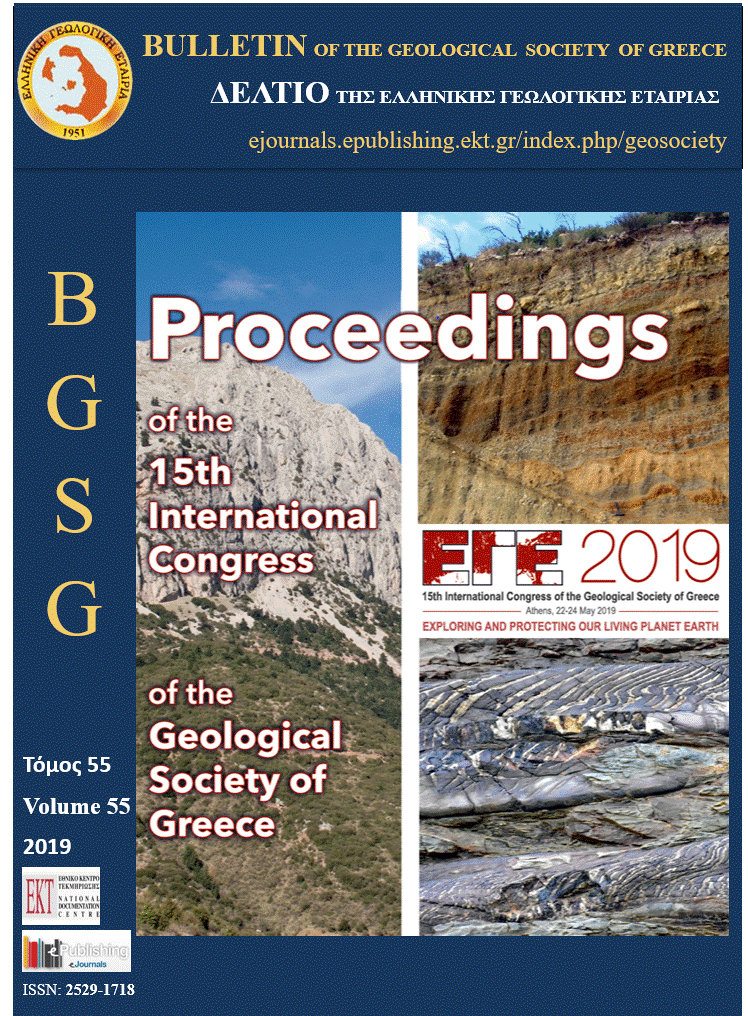Textural, Mineralogical and Geochemical Assessment of the Pikrolimni Lake Sediments (Kilkis District, Northern Greece) and Suitability for use in Pelotherapy
Περίληψη
Pelotherapy is the application of thermal muds (peloids) for recovering muscle, bone and skin pathologies. Specific criteria were established for the evaluation of the therapeutic suitability of peloids. Critical factors ruling the quality of the solid phase of peloids include granulometry, mineralogy, and physical-chemical properties. The aim of the present study was to investigate the textural, mineralogical and geochemical characteristics of the Pikrolimni Lake sediments (PLS), Kilkis district (N. Greece) in order to assess their suitability for application as raw material into mud therapy technologies. Representative PLS samples were collected and analyzed by means of different techniques at the analytical laboratories of the Hellenic Survey of Geology and Mineral Exploration (HSGME). Results showed that, texturally, the PLS were classified as sandy loam sediments. X-ray diffraction (XRD) study revealed that the PLS consist mainly of quartz, clay minerals (kaolinite, montmorillonite, illite), and muscovite, with minor feldspar and calcite. X-ray fluorescence (XFR) analysis showed that PLS samples have higher SiO2 and lower Al2O3 contents compared to the average shale composition. Among the analyzed, by means of inductively coupled plasma mass spectrometry (ICP-MS) technique, potentially toxic elements only As and Pb contents were found significantly higher than those of the average shale. Based on the calculated mean values of enrichment factor (EF) and geo-accumulation index (Igeo) PLS displayed minor enrichment and moderate contamination by Pb and As, respectively. In conclusion, an improvement of the grain size composition of PLS by means of a sieving process is needed. Besides, the study of the concentration and behavior of toxic elements in peloids formed by the mixing of the processed PLS with salty thermo-mineral water is proposed.
Λεπτομέρειες άρθρου
- Πώς να δημιουργήσετε Αναφορές
-
Sofianska, E., Athanassoulis, C., Tarenidis, D., Xirokostas, N., & Gkagka, M. (2019). Textural, Mineralogical and Geochemical Assessment of the Pikrolimni Lake Sediments (Kilkis District, Northern Greece) and Suitability for use in Pelotherapy. Δελτίο της Ελληνικής Γεωλογικής Εταιρείας, 55(1), 170–184. https://doi.org/10.12681/bgsg.21080
- Ενότητα
- Περιβαλλοντική Γεωλογία

Αυτή η εργασία είναι αδειοδοτημένη υπό το CC Αναφορά Δημιουργού – Μη Εμπορική Χρήση 4.0.
Οι συγγραφείς θα πρέπει να είναι σύμφωνοι με τα παρακάτω: Οι συγγραφείς των άρθρων που δημοσιεύονται στο περιοδικό διατηρούν τα δικαιώματα πνευματικής ιδιοκτησίας επί των άρθρων τους, δίνοντας στο περιοδικό το δικαίωμα της πρώτης δημοσίευσης. Άρθρα που δημοσιεύονται στο περιοδικό διατίθενται με άδεια Creative Commons 4.0 Non Commercial και σύμφωνα με την οποία μπορούν να χρησιμοποιούνται ελεύθερα, με αναφορά στο/στη συγγραφέα και στην πρώτη δημοσίευση για μη κερδοσκοπικούς σκοπούς. Οι συγγραφείς μπορούν να: Μοιραστούν — αντιγράψουν και αναδιανέμουν το υλικό με κάθε μέσο και τρόπο, Προσαρμόσουν — αναμείξουν, τροποποιήσουν και δημιουργήσουν πάνω στο υλικό.



